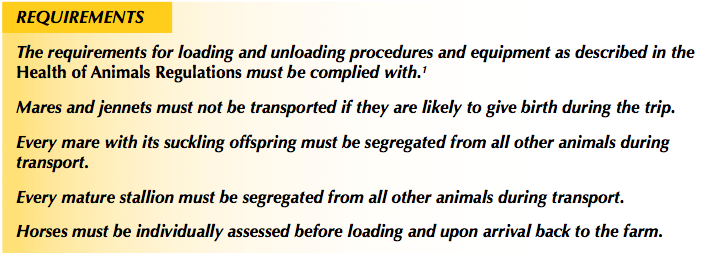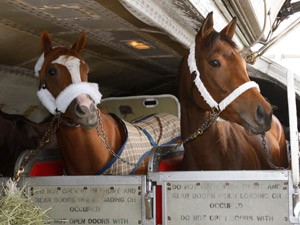Regulations of Road Transportation
The regulations for the transportation of live horses can be found in the “Code of Practice for the Care and Handling of Equines” and is developed by the National Farm Animal Care Council (NFACC). A copy of this document can be obtained at:
https://www.nfacc.ca/codes-of-practice/equine
The requirements for determining fitness of a horse for transport are as follows:
This says that as long as the owner or the transporter of the horse deems the horse fir then they are allowed to transport them. It does not require a trained professional to evaluate the horses prior to transportation.
If a horse is deemed fit for transport the owner or transporter must then satisfy these requiremnets:
This requirement could mean that it is acceptable for a horse travel for 24 hours without food, water or a rest. It may even be as much as 29 hours if the owner chooses to water and feed their horses up to the five-hour maximum prior to transport.
The requirements for loading and unloading the horses are as follows:
These requirements state that a mare can be transported even if she is in late stages of pregnancy as long as she is not expected to give birth at some point along the journey.
Once the transportation is complete…
Well at least that’s good news…
Regulations of Air Transportation
The regulations for transporting horses in the air are slightly different than regular road transportation regulations. The International Air Transport Association (IATA) has their own requirements for transporting horses and a copy of this can be accessed at:
http://canadianhorsedefencecoalition.files.wordpress.com/2013/11/iata-regs-for-horses1.pdf.
The IATA sets requirements for travel container size. They require that each container have a maximum of four horse stalls and these stalls must be at least the width of the animal plus three inches on each side.
The IATA also has requirements for handling during transportation. The IATA states: “to ensure flight safety, the presence of attendant(s) is generally necessary to supervise the behaviour of the animals and intervene if needed” they also require that: “attendants must have received adequate training. Especially, they must be qualified to administer tranquilizers and perform euthanasia”.





selidbe kamionom beograd